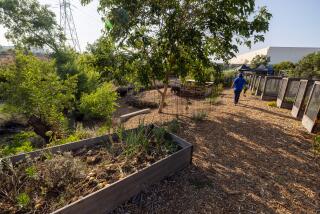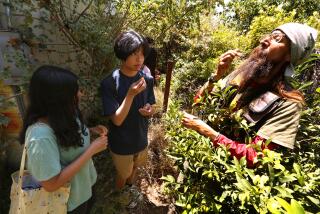Faraway Expeditions Add Insights to Science Classes
- Share via
This summer, eight area science teachers had the opportunity to do something they rarely have the chance to do--science.
Not reading about science or teaching science or taking a night course but actually doing scientific fieldwork on expeditions in the South Pacific and the Caribbean.
With grants of $1,600 from the Peter S. Bing family and the charitable Ahmanson Foundation, the eight participated in expeditions sponsored by Earthwatch, a nonprofit organization that arranges for volunteers to join scientific expeditions throughout the world.
This summer, the local teachers tracked spiny anteaters through the Australian outback, catalogued corals on a storm-battered reef in Fiji and studied medicinal plants in the Virgin Islands. They came back with new insights into the sciences they teach and with a renewed commitment to their profession.
They spent only a few weeks in the field. But as Culver City biology teacher Melinda Temple Ahdoot said: “It was as if I had been away for a year instead of a month. I came back so excited and eager to share the experience with my students.”
Five of the teachers went to Fiji where they surveyed a coral reef that had been severely damaged several years ago by a typhoon. The reef was being studied by University of Toronto ecologist David Kobluk before the storm, and the catastrophe gave him a rare opportunity to study a reef as it recovers from a natural disaster. Toby Manzanares, a Glendale resident and graduate of Franklin High School, described his fieldwork in Fiji as “a rich education.”
Unlike some of the others, Manzanares, who teaches biology at Schurr High School in Montebello, has done fieldwork before. He regularly takes students to Baja California to study the California gray whale. In Baja, he said, he and his students sometimes cannot sleep at night because of the singing of the nearby whales. “It sounds like they are in the next sleeping bag,” he said.
Fiji was no less fascinating for Manzanares. In addition to learning how to systematically survey a reef, a technique he intends to use with his own students when they study local tide pools, Manzanares mastered about 250 words of Fijian. He was also a guest teacher in several Fijian schools.
“I get bored very easily,” he observed. “That’s probably why I became a teacher. And this kind of experience is exactly what I need to keep my brain fine-tuned.” Manzanares hopes to take a group of his Montebello students to Fiji in the future.
Grants From Earthwatch
Each year, Earthwatch, which usually asks volunteers to pay their expenses as they work, gives grants to hundreds of teachers to study the giant clams of Tonga or fossilized sharks or Mexican building techniques. Headquartered in Watertown, Mass., the organization has an office in Pacific Palisades under the direction of Linda Knight. In addition to finding funding for teachers, Earthwatch also gives grants to high school students.
On their return to the United States, the teachers wrote lesson plans, which they shared with one another. Eventually, the Los Angeles County Office of Education plans to make the lessons available to other science teachers in the county.
Ahdoot, who lives in Sherman Oaks, has been a science teacher for 24 years. But until this summer, she had never done fieldwork. In July and August, Ahdoot spent 2 weeks on Kangaroo Island off the wild southern coast of Australia chasing the elusive echidna, a spiny anteater that is one of only two mammals in the world that both lay eggs and suckle their young (the other is the platypus).
Working with other volunteers under the direction of a zoologist from the University of Adelaide, Ahdoot pulled on heavy gloves and went out daily seeking echidnas. When she and her colleagues found the bristly creatures, they popped them into burlap sacks and brought them back to the field station where they were studied, their sexes determined and they were fitted with tiny transmitters before being returned to the wild.
Ahdoot learned that the gender of an echidna can be gleaned from its back feet. The males have spurs on both back feet; the females lack spurs or have only one (the females also have marsupial-like pouches). More important, she learned that the grand discoveries of science are grounded in the careful, systematic collection of data that doesn’t always seem important at the time.
“We did a lot of grunt work; that’s for sure,” said colleague Thomas Laughlin, a Hacienda Heights resident who teaches biology at Rowland High School in Rowland Heights. “But you feel like you are accomplishing something. You feel like you are part of something bigger.”
Warned of Hazards
The echidna seekers had been warned before their trip of the dangers they might encounter. “Ocean swimming is not recommended as the great white pointer sharks would like to eat you,” expedition leader Roger Seymour wrote in a briefing memo. “The greatest danger is falling or getting swept from the rocks on the coast or turning a vehicle over on the roads that are paved with pebbles like ball-bearings. Or you could get lost in the bush.”
But instead of poisonous snakes and other dangers, Ahdoot recalled one high point after another. “When you got up in the morning and went out of the research station, you had to wade through six to 10 kangaroos trying to get into the research station. If they got in, you had to walk them around in a circle to get them out because they can’t go backwards because of their big tails and back feet.”
In addition to studying Australian wildlife, the teachers had the opportunity to observe human adaptation in the outback. Instead of mailboxes, most of the island’s residents put out old refrigerators or barrels. As Ahdoot explained in an account of her trip made available to other teachers, “people who live a good distance from a town or a store order their groceries by phone. The school bus or another resident who might be going in that particular direction will drop off a neighbor’s order at their ‘mailbox.’ ”
Elizabeth Luke, who lives in Fontana and teaches biology, anatomy and physiology at Ganesha High School in Pomona, co-wrote several lessons with Wayne D. Johnson, who lives in Long Beach and teaches biology at Warren High School in Downey. Both surveyed corals in Fiji.
Johnson had previously studied seaweeds off the Palos Verdes Peninsula, but Luke had never before done fieldwork in marine biology.
“I’m from a landlocked state,” the Oklahoma native said, joking. Luke said the trip to Fiji, where she was a stranger in another culture, gave her insight into the feelings of her many non-American-born students. She said identifying and counting corals also gave her a new appreciation for “how resilient the environment is when man leaves it alone.”
The lessons Luke and Johnson developed are filled with detail from their Fijian field experience. One lesson deals with symbiotic relationships found on a coral reef and includes the example of the pearl fish, which lives a sheltered life inside the rectum of certain sea cucumbers. Another lesson asks students to weigh the virtues of protecting the endangered sea turtle against the very real needs of poverty-stricken natives who hunt the turtle and sell decorative objects made from it.
Lessons From the Field
The lessons of Laughlin and the others are similarly rooted in what they learned in the field.
Laughlin relates Australia’s odd wildlife to its geological isolation and includes a discussion of how the kangaroo got its name. When the English first arrived in Australia, they are said to have asked the Aborigines what this strange and wonderful animal was. When the Aborigines asked each other, in their own language, “What did he say? What did he say?” the English thought the sounds were the animal’s name.
In another lesson, Laughlin asks his students to weigh the pluses of opening wilderness areas to more people against the danger people pose to the wilderness.
Other teachers who went to Fiji were Donna Potts of South Pasadena, head of the science department at San Gabriel High School, and Charlotte Dudley, who teaches biology at Gardena High School.
The teachers praised the Earthwatch experience for the opportunity it gave them to do hands-on science (a major emphasis of the new California science curriculum) and for introducing them to like-minded teachers at other schools with whom they can share ideas.
Duane Nichols, who lives in Walnut and is head of the science department at Alhambra High School, worked on an archeology project in the U.S. Virgin Islands. He learned how the hibiscus and other plants were used as medicines by Africans taken to the islands as slaves. (The hibiscus was, and still is, made into a tea to treat colds.)
Nichols helped excavate a previously unknown site where a slave family had lived 300 years ago. While he was thrilled by the sense of discovery, he found he liked the donkey work of excavation far less than collecting oral histories from the elderly residents who are the last, fragile archives of much local lore.
Nichols said one of his missions now that he is back in school is reminding his students that they live on a planet as well as in a nation. And pointing out that they, too, can do remarkable things on their summer vacations.
More to Read
Sign up for The Wild
We’ll help you find the best places to hike, bike and run, as well as the perfect silent spots for meditation and yoga.
You may occasionally receive promotional content from the Los Angeles Times.






